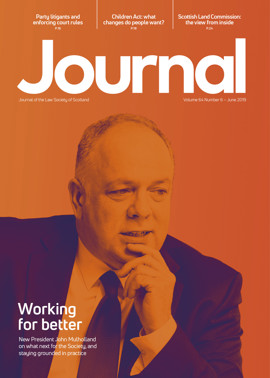The UNCRC: in our stride, or a giant leap?

A recent consultation issued by the Scottish Government calls for views on the implementation of the United Nations Convention on the Rights of the Child (UNCRC) into our domestic law in Scotland.
As it explains: “The UNCRC is one of the core United Nations (UN) human rights treaties. It sets out the civil, political, economic, social and cultural rights of every child, regardless of their race, religion or abilities.
“The UK ratified the UNCRC in 1991 and since then has been obliged under international law to give effect to the rights set out in the UNCRC. The UK has also signed the optional protocol on the involvement of children in armed conflict and the optional protocol on the sale of children, child prostitution and child pornography. A further optional protocol which allows complaints to be made to the UN Committee on the Rights of the Child has not yet been signed by the UK. While the UK is bound by the UNCRC in international law, because the UNCRC has not been incorporated into domestic law, those rights are not part of the law which can be enforced directly in Scottish courts.”
Scotland has arguably already partially implemented the UNCRC through the legislation affecting education, looked-after children and child protection, such as the Carers (Scotland) Act 2016 and Social Care (Self-directed Support) (Scotland) Act 2013. So what could the next step of full implementation mean for children, and how will it ensure effectiveness? Full incorporation is likely to see a shift towards a rights-based approach in decision making and in the culture of response for children’s rights (Lundy et al, The UN Convention on the Rights of the Child: a study of legal implementation in 12 countries, UNICEF, November 2012, p 4).
Implementation to date
To date, Scotland has implemented several principles through its legislation. For example, article 3 (“best interests of the child”) can be seen in the Adoption and Children (Scotland) Act 2007, and article 2 (“ensure that the child is protected”) through the measures offered to public bodies to take action to seek legal responsibility where necessary to protect a child. These are in limited areas, for example education, child protection, or adoption and permanence. To implement the UNCRC fully will see a seismic shift to requiring everyone in all areas involving children to recognise their rights, support these and take a children’s rights approach in decision making. This will help move away from what could be considered a muddled landscape of children’s rights, as they currently exist in Scotland.
It may be that the legislation could require consideration of rights, for example in school policies where there is no requirement for consultation with pupils, and as part of any equality or integrated impact assessment in decision making, as is the case for the Fairer Scotland Duty issued under the Equality Act 2010, part 1 (in effect from April 2018).
The practicalities of involving children in decision making should be addressed, especially where there are proposals to change services that deliver care to children, or which may affect them.
It will be imperative that those decision makers, advocates, reporters and arbiters – be they children’s panel, judge or sheriff – all fully comprehend the true meaning of the UNCRC rights and are able to support and give effect to them. This requires real investment in the systems which will be pressed to support them, at a time when these are without doubt under constant pressure to deliver services and meet the demands pressed on them. This extends from local authorities to the Scottish Courts & Tribunals Service.
Valiant efforts are and have been made by authorities to recognise and support children’s rights. Even the recent changes in court forms notifying children of actions and offering them an opportunity to provide their views go some way to demonstrate that. However, as can be seen from the recent decision in Petition of CDF and DCF to adopt MRFW [2019] CSOH 37, senior judges may still choose to rely on a curator, who is a solicitor with no specific training in relation to working with children, to inform them of what might be in the child’s best interests.
The role of a curator or reporting officer is, and should be, restricted to reporting back on the facts, and not offering opinion without having all facts to hand. Embedding the UNCRC would offer a basis to challenge these views from a child’s perspective and ensure a requirement to seek children’s views properly and fully. The Scottish Government is still considering whether to remove the age of 12 years as being the point at which a child’s view should be sought – it featured in the recent consultation on part 1 of the Children (Scotland) Act 1995 – and whether there should be an age threshold on when to seek views.
Embedding UNCRC should mean all children being asked for their view, and guidance and support to do that will be required. Services and public bodies need supported to provide that, as well as the courts through allocated children’s rights officers or better training of existing curators/reporting officers/child welfare reporters. Only one sheriff court in Scotland currently has a funded children’s rights officer, who consults with children in domestic assault cases, reporting directly to the sheriff. (The Children and Young Persons’ Commissioner has worked with other bodies to better support children in domestic assault cases through the Power Up Power Down project.)
Corporate parenting has also highlighted the need for public bodies to recognise the importance of and need to consider children’s rights, as has the creation of the CYP Commissioner in Scotland. Embedding the UNCRC into domestic law will move these efforts forward and empower bodies responsible for children to support, advocate and enforce children’s rights.
Legal expression
It remains to be seen which legal mechanism will be used by the Scottish Government in embedding these rights: “there is no single approach to incorporation of an international convention into domestic law… it is for individual states to decide how best to make children’s rights real in their particular country” (consultation, p 11).
It is notable that the Government suggests that the “usual method of implementing treaties… has been through detailed legislation giving effect to the rights set out in the treaty in a way which fits into our existing law”, as opposed to implementing the treaty rights directly and in the general terms expressed. It adds that legislation will likely be framed in a way that blends with Scotland’s ideology and circumstances. Is the Government keen to use this opportunity to shape the rights in a way which supports children as it sees fit (as can be seen from its support for the smacking ban, a divisive issue), maybe differing from what the treaty envisaged all those years ago? The rights could then become more specific and less enforceable as standalone rights.
The consultation also suggests (p 13) that the children’s hearings system removes children in need of protection, guidance, treatment or control from the court system, and places the welfare of children at the core of its decision making. That is to suggest this is a system without flaws or failure. Surely properly embedding UNCRC means no opt-outs, and that if something already exists which supports and lends itself to those rights then all the better? If we are moving away from the mixed landscape of legislation specific to areas such as education, child protection etc, would it be appropriate to consider full implementation of the UNCRC so that all children in whatever walk of life can enforce those rights?
As seen from the implementation of human rights law, this is not without its challenges and difficulties, in interpreting and applying those rights.
There will, if UNCRC is implemented, be a real need for understanding of those rights and for support to embed them at all stages of decision making, and a need to provide organisations or public bodies with appropriate resources to do that.
Left to the judges?
Introduction of the UNCRC in whatever form is likely to lead to judicial challenge on decisions, or failures, to recognise the rights. Reliance on the judiciary to interpret weak legislation is far from being their role, yet it is all too often required. It should also not be left to the judiciary to provide direction for the role of enforcer. The consultation should consider whether the CYP Commissioner for Scotland could be provided with additional powers to ensure legislation is not toothless and to challenge those who fail to implement and embed the UNCRC in legislation. The consultation should hopefully bring about discussion of these and many more issues, in what could be a real crosscutting piece of legislation for children’s rights.
The consultation is open until 14 August 2019, and everyone, not just public bodies, should consider the far reaching implications of this cultural shift for children’s rights in Scotland.
Useful links
UNCRC Treaty published by UNICEF
Perspectives
Features
Briefings
In practice
- Tradecraft – one solicitor's experience
- Dear employer...
- Team building – for the Foundation?
- Accredited paralegal practice area highlight: conveyancing
- Accredited Paralegal Committee profile
- What's new for paralegals?
- Ask Ash
- Managing the risk of workplace stress
- Appreciation: Iain Alexander Macmillan
- Revealed – by your AML certificates






